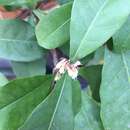The Miracleberry (
Synsepalum dulcificum) (family Sapotaceae) is a large shrub (reaching 2 to 5 m tall) with dense foliage clustered at the tips of its many slender branches. It is
native to West and West-Central tropical Africa. This plant is best known for its red berries, which contain a
glycoprotein known as
miraculin. Miraculin has the remarkable property of modifying sour tastes into into sweet (Kurihara and Beidler 1968). William Freeman Daniell (1852, cited in Kurihara and Beidler 1968) provided the first report in the scientific literature of this unusual property of Miracleberry fruits. The taste-modifying activity of miracleberries is evident only at acidic pH. Miraculin is able to elicit sweetness from dilute formulations of various acids, including hydrochloric acid, oxalic acid, lactic acid, formic acid, acetic acid, and citric acid; the sweetening effect is dependent on the sourness and the pH of the acid (Kurihara and Beidler 1969). The sweetening effect of a miraculin solution reaches its maximum level after being held in the mouth for approximately 3 minutes (Kurihara and Beidler 1969). The taste-modifying effect can be sustained for more than an hour, although this depends on the concentration of the miraculin solution. Miraculin differs from most other "sweet-tasting" proteins in that it is a taste
modifier, without itself having a sweet taste. In general, "sweet-tasting" proteins may be classified into three categories: the protein itself is sweet (
thaumatin,
monellin,
mabinlins,
pentadin and
brazzein), the protein induces sweetness (
miraculin), or both (neoculin, the heterodimeric form of
curculin) (Hiwasa-Tanase et al. 2012). A
New York Times article in February of 2011 included an interview with a chef who suggested (plausibly or not!) that miracleberries could be used to help alleviate world hunger by broadening our perception of what constitutes food to include some nutritious wild foods that may not normally be very palatable to humans. The article also cited promising research by an oncologist investigating possible benefits from miracleberries for chemotherapy patients, who often lose their appetites because food tastes rubbery, metallic, or bland to them. Efforts to understand the biochemistry and neurophysiology behind the taste-modifying effect of miraculin began in the 1960s and have continued to the present (e.g.,Inglett et al. 1965; Brouwer et al. 1968; Kurihara and Beidler 1968; Paladino et al. 2010; Koizumi et al. 2011). According to Irvine (1961, as cited in Inglett and May 1968), in Ghana Miracleberry is found growing on farms and around dwellings, occurs in fringing forests, and is common on the coast. From December to June, it yields ripe red ellipsoidal fruits, about 2 cm long, that are composed of a thin layer of pulp surrounding a single large seed. (Inglett and May 1968) In addition to the value of the fruit as a taste modifier, the skin and pulp of miracleberries may also have antioxidant properties with possible benefits for human health (Inglett and Chen 2011). Currently, miracleberries and miraculin are expensive. The plant cannot survive at less than 7 C, requires several years before it can bear fruit, and has a low fruit yield following pollination. Furthermore, the taste-modifying activity of the fruit is lost after harvest within 2 to 3 hours at room temperature. Due to the great commercial potential of miraculin, there has been great interest in developing an efficient method of producing large quantities of pure miraculin efficiently. In recent years, significant progress has been made in developing transgenic plants (such as tomatoes) that would allow pure miraculin to be produced efficiently for commercial use. (Hirai et al. 2010; Hirai et al. 2011; Duhita et al. 2011; Hiwasa-Tanase et al. 2012 and references therein)

